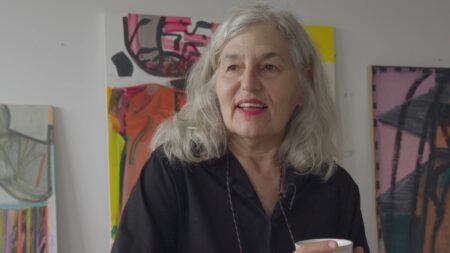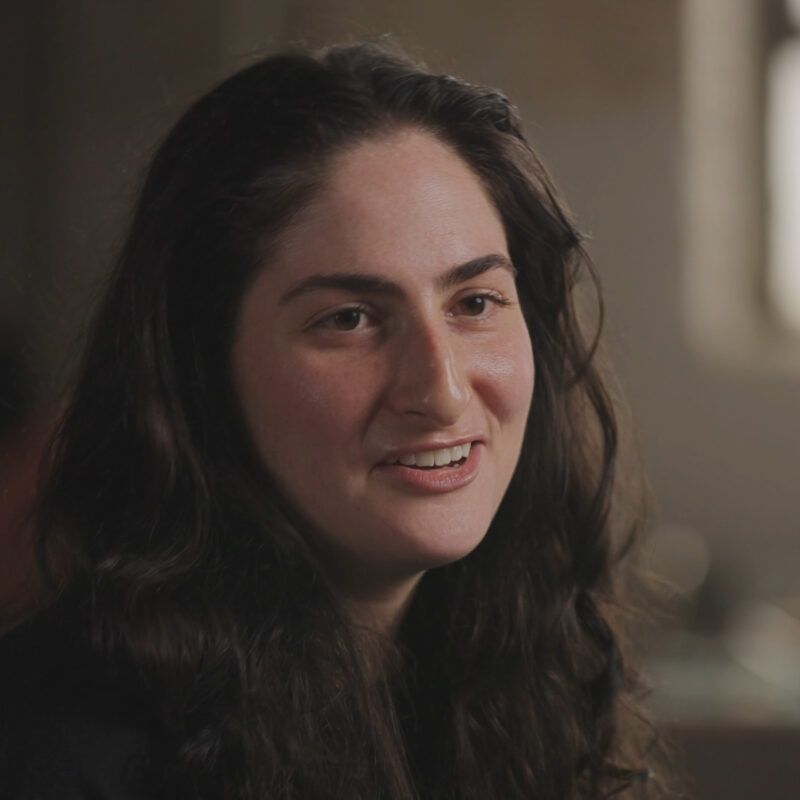Continue playing
(Time remaining: )
Play from beginning
Continue playing "{{ controller.videos[controller.getVideo(controller.currentVideo)].segmentParentTitle}}"
{{controller.videos[controller.getVideo(controller.currentVideo)].title}} has ended.
Hannah Levy's Adaptive Structures
Steel and glass populate artist Hannah Levy’s 2023 exhibition Crutch at Casey Kaplan Gallery in New York City, taking familiar materials, forms, and structures and making them strange, even threatening. Levy’s work contemplates the human body, our anxieties about its fleshy materiality, how it interacts with the world around us, and its vulnerability. “I think a lot about the term body anxiety,” says the artist. “We’re all moving around in these flesh cages that are essentially vulnerable.” At her studio in the Bronx, Levy describes the ad hoc processes she develops to make her unique sculptural forms, calling herself a “professional amateur” as she adapts existing processes to her needs. Her sculptural practice stems from a childhood experience when she was first introduced to modernist design and, as a result, became interested in working with tubular steel, a material found in a plethora of everyday objects ranging from barbells to crutches to school desks to turnstiles. Using this material, Levy considers the interactions between hard, inorganic materials and organic materials, frequently represented in her sculptures using silicone.
At UrbanGlass in Brooklyn, New York, the artist makes a series of glass sculptures for Crutch, casting the glass to resemble warty, sagging gourds that will eventually lay limply over thorny steel bars affixed to the walls of the gallery. Unlike working with silicone, which is stretched, squeezed, and acted upon in her sculptures, her work in glass acts as a record of a past action. Levy remarks: “It’s frozen in time in that moment of this sag or flop or squeeze.” Throughout Crutch, the artist references adaptive structures, many of which can be found in our built environment but often go unnoticed, like handrails in stairways or grab bars in bathrooms. “With these objects, there’s this knowledge that if they’re not something you require in your life now to be mobile, you will at some point,” says Levy. “We all have this relationship to them that is one of inevitability.” Like much of her work, the sculptures in Crutch draw from multiple sources, as in a series of works that merge the early 20th-century design of the Paris Métro with the Hoyer lift, a medical device designed to lift and transport people with limited mobility. By referencing these structures in her work, Levy takes them out of the context in which we know them and brings new attention to them.
More information and creditsCredits
Director & Producer: Andrea Yu-Chieh Chung. Executive Producer: Tina Kukielski. Series Producer: Nick Ravich. Editor & Animator: Kira Dane. Cinematography: César Martínez Barba, Jane Macedo Yang. Sound: Ana Fernández, Fivel Rothberg. Assistant Curator: Jurrell Lewis . Color Correction: Max Blecker. Sound Design & Mix: Collin Blendell. Design & Graphics: Chips. Visual Effects: Yasmin Mistry. Music: Maya Belsitzman, Tamuz Dekel, Matan Ephrat, mee. Assistant Editors: Stephanie Cen, Michelle Hanks
Artwork Courtesy: Hannah Levy. Archival Media Courtesy: Louisiana Channel, La Biennale di Venezia. Thanks: Abram Deslauriers, Casey Kaplan Gallery, Shuhei Fujii, Dorie Guthrie, Andrew Hughes, Veronica Levitt, UrbanGlass
New York Close Up is made possible with support from Miyoung Lee and Neil Simpkins, The Andy Warhol Foundation for the Visual Arts, public funds from the New York City Department of Cultural Affairs in partnership with the City Council, the New York State Council on the Arts with the support of the Office of the Governor and the New York State Legislature, the Henry Nias Foundation, and individual contributors.
Closed captionsAvailable in English, German, Romanian, Italian, Japanese, Korean, Chinese, Italian
Through the Art21 Translation Project, multilingual audiences from around the globe can contribute translations, making Art21 films more accessible worldwide. Translate this video now.
Interested in showing this film in an exhibition or public screening? To license this video please visit Licensing & Reproduction.
Hannah Levy was born in 1991 in New York City, New York, where she currently lives and works. The artist received a BFA from Cornell University in 2013 and a Meisterschüler title from Städelschule in Frankfurt am Main in 2015. Levy’s sculptures are uncannily familiar, transforming ubiquitous elements of interior design into unnamable objects that appear to merge the organic and the industrial. Through her practice, the artist calls attention to the relationship between our bodies and the built environment, considering how we are impacted by the design choices around us.
“To me, there’s this very visceral moment that can lead itself to this kind of sculptural way of thinking around the way that a body interacts with the furniture and its environment.”
Hannah Levy

